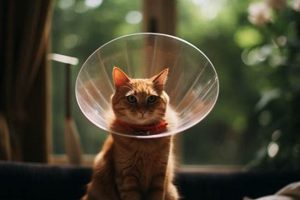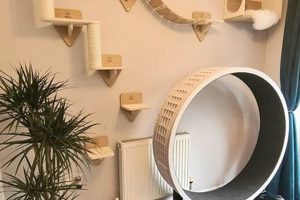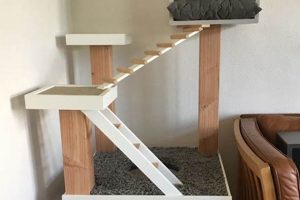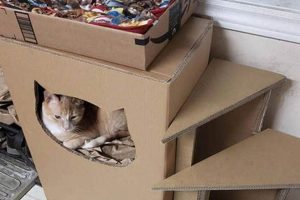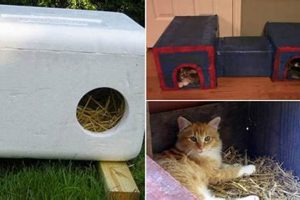A self-assembled portal designed to allow feline access through a glazed opening, typically a window, facilitates independent movement for domestic cats. This construction usually involves creating an appropriately sized opening within a panel that can be securely fitted into the window frame. The resulting passage is then equipped with a flap or other mechanism to control airflow and maintain insulation.
Creating such a passage offers benefits related to pet autonomy and owner convenience. It alleviates the need for constant human intervention in letting the animal in or out, which can improve the pet’s welfare by offering a greater sense of freedom. Historically, pet doors have been adapted for various entry points, with window modifications becoming increasingly popular in urban environments or rental properties where permanent structural changes are restricted.
The following sections will detail the key considerations in designing and constructing such a portal, including material selection, sizing guidelines, installation techniques, and safety measures to ensure a secure and functional outcome.
Essential Considerations for Constructing a Feline Window Access
The creation of a through-window portal for cats requires careful planning and execution to ensure both functionality and the animal’s safety. The following are essential points to consider during the construction process.
Tip 1: Precise Measurement and Sizing: Prior to any cutting or construction, accurate measurements of the cat are crucial. The opening must be large enough for comfortable passage but small enough to prevent access by larger animals or unauthorized entry.
Tip 2: Material Selection for Durability: Choose materials that are weather-resistant, durable, and non-toxic. Common choices include acrylic sheets, exterior-grade plywood, or PVC panels. Ensure the materials are smooth and free of splinters or sharp edges.
Tip 3: Secure and Stable Installation: The constructed panel must be securely fitted within the window frame. This may require custom-cut pieces and weather stripping to ensure a snug and draft-free fit. Employ appropriate fasteners to maintain stability.
Tip 4: Flap Mechanism Functionality: The flap mechanism should swing freely and close securely. Magnetic closures or weighted flaps can help maintain insulation and prevent unwanted drafts. Regular inspection and maintenance of the flap mechanism are required.
Tip 5: Weatherproofing and Insulation: Proper sealing around the panel edges and the flap mechanism is crucial for preventing drafts and water damage. Consider using weather stripping or foam insulation to improve energy efficiency.
Tip 6: Security Considerations: Assess potential security vulnerabilities. The installed portal should not compromise the overall security of the residence. Consider adding additional locking mechanisms or security screens.
Tip 7: Gradual Acclimation for the Cat: Introduce the cat to the new passage gradually. Use positive reinforcement techniques, such as treats or praise, to encourage the cat to use the portal. Supervise initial interactions to ensure comfort and safety.
By adhering to these guidelines, a functional and safe feline access point can be established, contributing to the animal’s well-being and the owner’s convenience.
The final section will address potential challenges and offer solutions for troubleshooting common problems that may arise during construction and usage.
1. Precise Sizing
Accurate dimensional planning is foundational for the successful integration of a self-assembled feline access portal within a window. Appropriate sizing directly impacts the usability, security, and the animal’s comfort level when using the constructed opening. Inadequate dimensions can render the passage unusable or create potential safety hazards.
- Feline Body Dimensions
The internal measurements of the portal must accommodate the cat’s broadest dimensions during normal movement. This includes height at the shoulders, chest width, and body length. Insufficient height can cause discomfort or hesitation, while inadequate width may restrict movement and potentially lead to injury. Example: A large Maine Coon will require significantly larger dimensions than a smaller breed, such as a Siamese. Failure to account for this can result in a non-functional passage.
- Clearance and Maneuverability
Beyond simply fitting the cat’s body, the portal needs to allow for comfortable maneuvering. This includes space for turning, stepping through without obstruction, and clearance for the tail. Restricting these movements can lead to anxiety and reluctance to use the access point. Example: If the opening is placed too close to the floor, the cat might struggle to navigate it comfortably, potentially leading to scratching or attempts to bypass the portal altogether.
- Flap/Door Mechanism Accommodation
If the design incorporates a flap or door, the dimensions must account for its swing radius and any associated hardware. A flap that is too large or heavy can create resistance, discouraging the cat from using the portal. Conversely, a flap that is too small may not provide sufficient weather protection. Example: A rigid plastic flap that extends too far into the interior space could hinder the cat’s ability to easily enter or exit, particularly for elderly or less agile felines.
- Security Considerations
Oversized openings present a security risk. They may allow access to larger animals or compromise the overall security of the window. The dimensions should be carefully balanced to accommodate the cat while minimizing the potential for unwanted entry. Example: An opening that is unnecessarily large could allow raccoons or other small animals to enter the residence, creating a nuisance or potential hazard.
The interplay of these dimensional factors underscores the importance of careful measurement and planning prior to commencing construction. Failure to address these aspects adequately can compromise the functionality and safety of the self-assembled feline access solution.
2. Secure Installation
The stability and integrity of a self-assembled feline access portal within a window are fundamentally dependent upon secure installation. Improper installation can compromise the structure’s functionality, creating hazards for the animal and potentially breaching the security of the residence. Therefore, adherence to stringent installation practices is paramount.
- Frame Integration and Support
The constructed portal must be seamlessly and rigidly integrated within the existing window frame. This requires precise measurements, custom-cut components, and robust fastening mechanisms. Gaps or loose connections can lead to instability, air leaks, and potential dislodgement. Example: A poorly fitted panel secured with inadequate fasteners may shift during inclement weather, creating a gap that compromises insulation and potentially allows water intrusion.
- Fastener Selection and Placement
The choice of fasteners (screws, bolts, adhesives) must be appropriate for the materials being joined and the stresses they will endure. Fasteners should be strategically placed to distribute the load and prevent warping or separation. Using incorrect fasteners can lead to premature failure and structural instability. Example: Employing drywall screws to secure a plywood panel to a metal window frame will likely result in stripping and a weak connection, rendering the installation prone to failure.
- Weatherproofing and Sealing
A secure installation includes effective weatherproofing to prevent air and water infiltration. This requires the application of appropriate sealants, weather stripping, and flashing materials. Inadequate sealing can lead to drafts, moisture damage, and increased energy costs. Example: Failing to seal the perimeter of the installed panel will allow cold air to enter during winter, increasing heating bills and creating an uncomfortable environment near the window.
- Security Reinforcement
The installation should not compromise the pre-existing security of the window. Reinforcement measures may be necessary to prevent unauthorized entry. This could include adding locking mechanisms, security screens, or reinforcing the surrounding window frame. Example: If the DIY portal replaces a standard window pane, the original locking mechanism may be rendered useless. A new locking mechanism should be installed to maintain the security of the window.
These interlinked facets of secure installation are crucial for ensuring the long-term functionality, safety, and security of a feline window access portal. A failure to adequately address any one of these areas can undermine the entire structure, negating the benefits of the project and potentially creating unintended consequences.
3. Material Durability
The longevity and functionality of a self-constructed feline access portal within a window are intrinsically linked to the inherent durability of the materials employed in its fabrication. The structure is subjected to continuous environmental stressors, including temperature fluctuations, moisture exposure, and physical wear from the animal’s usage. Consequently, the selection of robust, resilient materials is not merely a cosmetic consideration but a fundamental determinant of the portal’s lifespan and sustained performance. Failure to prioritize material durability invariably results in premature degradation, necessitating frequent repairs or complete replacement, thereby negating the cost-effectiveness of the initial self-build initiative. Example: Untreated plywood, while inexpensive, rapidly deteriorates when exposed to rain and humidity, leading to warping, delamination, and ultimately, structural failure of the cat door.
The practical implications of material selection extend beyond mere structural integrity. The chosen materials directly impact the ease of maintenance, resistance to pest infestation, and overall aesthetic appeal. Durable materials, such as acrylic or PVC, are typically easier to clean, less susceptible to damage from scratching or chewing, and inherently resistant to mold and mildew growth. Conversely, porous materials may harbor bacteria and odors, requiring more frequent and intensive cleaning. Furthermore, the ability of the chosen material to withstand prolonged exposure to ultraviolet radiation directly influences its colorfastness and resistance to cracking or fading. Example: A dark-colored plastic panel constructed from a low-grade polymer will fade and become brittle over time, detracting from the aesthetic appeal of the window and potentially creating sharp edges or splinters that could injure the animal.
In summation, the material durability of a self-assembled feline access portal represents a critical design consideration, influencing not only the structural integrity and lifespan of the unit, but also its maintainability, aesthetic appeal, and long-term cost-effectiveness. While the initial cost of more durable materials may be higher, the extended service life, reduced maintenance requirements, and enhanced safety they provide represent a significant long-term value proposition. The selection of appropriate materials should, therefore, be based on a comprehensive assessment of environmental conditions, usage patterns, and the animal’s individual characteristics to ensure a durable, safe, and aesthetically pleasing integration with the existing window.
4. Weather Resistance
The ability to withstand environmental elements is paramount in the design and construction of a self-assembled feline access portal integrated into a window. Inadequate weather resistance directly correlates with structural degradation, compromised insulation, and potential harm to the animal. Exposure to precipitation, temperature fluctuations, and ultraviolet radiation necessitates the use of materials and construction techniques that mitigate these effects. The ingress of water, for instance, can lead to rot in wooden components, corrosion in metallic elements, and the growth of mold and mildew, all of which diminish the portal’s lifespan and pose health risks. Similarly, temperature variations can induce expansion and contraction in materials, leading to cracks, warps, and breaches in the structure’s integrity. A direct consequence of poor weather resistance is a reduction in the thermal efficiency of the window, resulting in increased energy consumption for heating and cooling the interior space. Example: A cat door constructed with inadequate sealing allows drafts, increasing heating costs during winter. This illustrates the practical significance of prioritizing weather resistance in the design phase.
Effective mitigation strategies include selecting weather-resistant materials such as PVC, acrylic, or treated lumber. Furthermore, the application of sealants, weather stripping, and flashing is crucial for preventing water infiltration and air leakage around the portal’s perimeter. Consideration must also be given to the flap mechanism, ensuring it forms a tight seal when closed to minimize drafts. UV-resistant coatings can be applied to protect materials from degradation caused by sunlight exposure. The long-term performance of the installation hinges on these preventive measures. A real-world application is sealing the cat door’s frame with silicone caulk to prevent water from seeping into the house during heavy rain. This ensures the cat has dry access and prevents structural issues related to water damage.
In conclusion, weather resistance is not merely an ancillary feature but a fundamental requirement for a durable, functional, and safe feline access portal. The selection of appropriate materials, the application of effective sealing techniques, and the implementation of preventive measures against environmental degradation are essential for ensuring the long-term performance and viability of the self-assembled structure. Addressing these considerations upfront mitigates the risk of premature failure, reduces maintenance costs, and safeguards the well-being of the animal.
5. Animal Acclimation
Successful integration of a self-constructed feline access portal within a window hinges significantly on animal acclimation. The sudden introduction of an unfamiliar passage can induce stress, anxiety, or fear in the animal, potentially leading to rejection of the new access point. The animal’s comfort level and willingness to utilize the portal directly impact the project’s overall success. For example, a cat accustomed to human-controlled door access may hesitate to use a self-operated flap, perceiving it as a barrier rather than an invitation. Gradual acclimation techniques, coupled with positive reinforcement, are therefore essential to encourage the animal to adopt the new routine. The absence of such measures often results in the cat reverting to previous behaviors, such as scratching at the door or vocalizing to request human assistance, thereby negating the intended convenience of the installation.
Acclimation strategies often involve a multi-stage process. Initial exposure may entail simply allowing the animal to investigate the portal in its open state, without requiring passage. Familiar scents or toys can be placed near the opening to create a positive association. Progressively, the animal can be guided through the portal with treats or verbal encouragement. The flap or door mechanism should be introduced gradually, ensuring minimal resistance or noise to avoid startling the animal. For instance, initially propping the flap open allows the cat to become accustomed to the opening before fully engaging with the door’s mechanism. Patience is crucial; forcing the animal through the portal can create negative associations and impede the acclimation process. The timing and pace of introduction should be adjusted based on the individual animal’s temperament and comfort level.
In summary, animal acclimation represents a critical component of implementing a feline access portal. Failure to prioritize this aspect can undermine the entire project, rendering the newly constructed passage unusable. By employing gradual introduction techniques, positive reinforcement, and adapting to the animal’s individual needs, the likelihood of successful integration is significantly increased, thereby realizing the intended benefits of increased pet autonomy and owner convenience. The challenge lies in tailoring the acclimation process to the unique characteristics of each animal, requiring observation, patience, and a willingness to adapt the approach as needed.
Frequently Asked Questions
The following section addresses common inquiries regarding the design, construction, and implementation of self-assembled feline access portals within windows. The information presented aims to provide clarity and guidance to those considering such a project.
Question 1: What is the optimal size for a through-window portal for a cat?
The appropriate dimensions are contingent upon the size and breed of the cat. A minimum opening of 6 inches wide by 8 inches high is generally recommended for smaller breeds, while larger breeds may require dimensions of 8 inches wide by 10 inches high. These measurements should allow for comfortable passage without undue restriction.
Question 2: What materials are best suited for constructing a durable and weather-resistant cat door?
Exterior-grade plywood, acrylic sheets, and PVC panels are suitable choices due to their resistance to moisture and wear. The selected material should be non-toxic and free of sharp edges or splinters to ensure the animal’s safety.
Question 3: How can drafts and heat loss be minimized with a window-mounted cat door?
Effective sealing around the perimeter of the installed panel is essential. Weather stripping, foam insulation, and a well-fitting flap mechanism can significantly reduce drafts and heat loss. Magnetic closures or weighted flaps are beneficial for maintaining a tight seal.
Question 4: Does installing a cat door compromise the security of the residence?
Improperly installed cat doors can present a security vulnerability. Reinforcing the surrounding window frame, adding a locking mechanism to the panel, and ensuring the opening is not excessively large can mitigate this risk.
Question 5: What is the best method for acclimating a cat to a new window access portal?
Gradual introduction is recommended. Allowing the cat to explore the open portal initially, using positive reinforcement such as treats, and slowly introducing the flap mechanism can encourage acceptance. Patience and consistency are crucial.
Question 6: How often should a window-mounted cat door be inspected and maintained?
Regular inspections are advised, ideally on a monthly basis. The flap mechanism should be checked for proper function, and any signs of wear, damage, or water infiltration should be addressed promptly to ensure continued performance and safety.
These answers provide a general overview of common concerns. Specific implementations may require adjustments based on individual circumstances and the animal’s particular needs.
The subsequent section will explore troubleshooting techniques for resolving common issues encountered during the construction and usage phases.
DIY Cat Door for Window
This exploration of the self-assembled feline access portal, specifically the diy cat door for window, has underscored the critical considerations surrounding its design, construction, and implementation. From precise sizing and secure installation to material durability, weather resistance, and animal acclimation, each element plays an integral role in ensuring a functional, safe, and long-lasting solution. The presented information aims to equip individuals with the knowledge necessary to navigate the complexities of such a project.
The decision to undertake the construction of a diy cat door for window should be approached with diligence and a thorough understanding of the outlined principles. A successful outcome hinges on careful planning, precise execution, and a commitment to prioritizing both the animal’s well-being and the security of the residence. Ultimately, a well-executed project can enhance the lives of both the animal and its owner, providing increased autonomy and convenience. The long-term benefits of this undertaking are realized only through informed decision-making and meticulous attention to detail.


